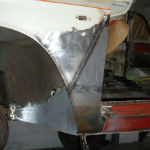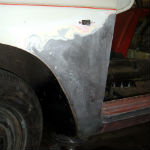MIG, TIG, Gas?
For a number of years now the MIG welder has been the tool of choice for most garages and home restorers. It is cheap, easy to use and produces a good quality (i.e. strong) weld at a rate unmatched by any other welding process. Now for the bad points....The MIG welding process results in a large volume of filler material (the weld 'bead') being added to the work piece which causes two undesirable affects; firstly, a massive and prolonged temperature rise in the work piece resulting in permanent distortion (this will take place within just a few seconds from the start of the weld). Secondly, all of that filler material must be ground off before further work can be carried out (filling, painting, etc.).
Distortion is a problem on all bodywork repairs, but becomes a real headache on on any vehicle with large flat panels (Type 2's - Split screens & Bays - Type25's, etc.) where a small MIG welded repair can result in a large amount of filler being required!
On the other hand, when TIG welding is properly used, little or no filler material need be added to the weld pool (I estimate that roughly 80 - 90% of any weld length will be achieved without filler material). This, coupled with the pin-point delivery of the TIG heat source results in much less heat build up in the panel and so less distortion. It also leaves the craftsman with a weld that may be successfully worked with a hammer and dolly to produce a near nett finish and so minimise the amount of body filler that will need to be applied before the panel may be painted.
As for Gas welding, well this is basically the same as the TIG process and so shares some of the benefits (less filler material going into the weld pool and a workable weld results), but the gas flame is not nearly as fine as that produced by the TIG set, and is also something like only one third the temperature. This means that the work takes longer to come up to temperature resulting in more heat dissipating through the panel and so distortion is a real problem. However, Gas is still a preferred method (compared to MIG) for body repairs. Gas and TIG both provide the user with a tool that will weld, braze and enable the shrinking of distorted panels.
In Conclusion
I've probably gone on too much already, but I do feel passionately about this. Suffice to say that, for bodywork restoration at least, TIG welding really is the best that can be done for your VW. If you were to walk into a workshop specialising in the restoration of Ferrari, Rolls Royce, or any vintage (read valuable) car, you would find craftsman using TIG or Gas welding sets to produce top quality, long lasting repairs in the time honoured fashion, the MIG welder being used to make braketry and workshop tools only!
Tips for a successful welded repair
- Cut out ALL rot (obvious but often overlooked)
- Buy or fabricate the best quality repairs possible
- Repair panel should be an exact 'edge to edge' fit with surrounding panel
- Weld in repair pieces 'edge 2 edge' (no lap joints!)
- Tack weld at short intervals, then fill in the gaps!
- Weld - hammer & dolly - Weld - hammer & dolly - Weld - hammer & dolly....... you get the picture!
- Remove excess weld with a body file
- Avoid angle grinders - too aggressive
- Use Zinc spray and waxoil to protect all surfaces not finished in body colour
- If this sounds easy - it is not!!
If you have got this far and are still awake, then please give us a call to discuss your project.



